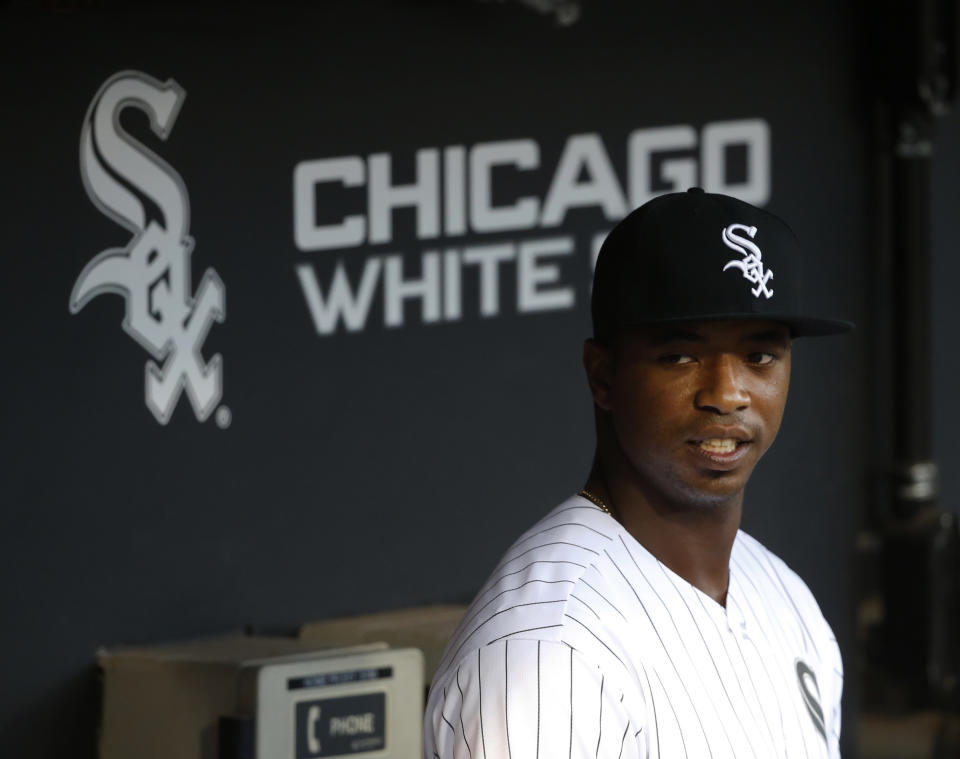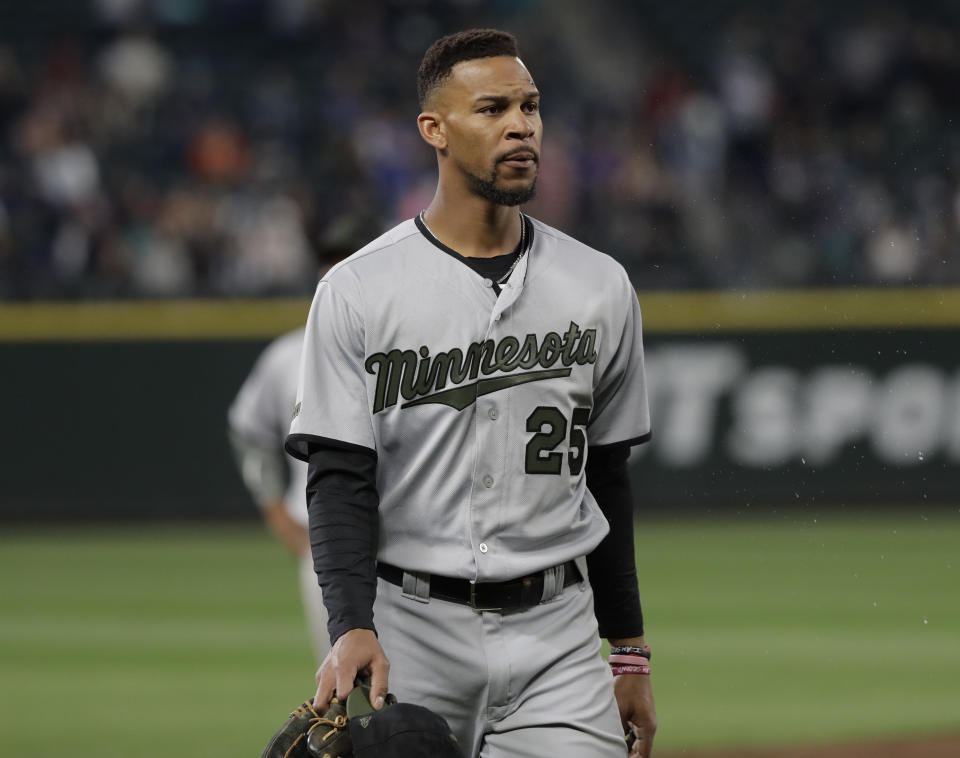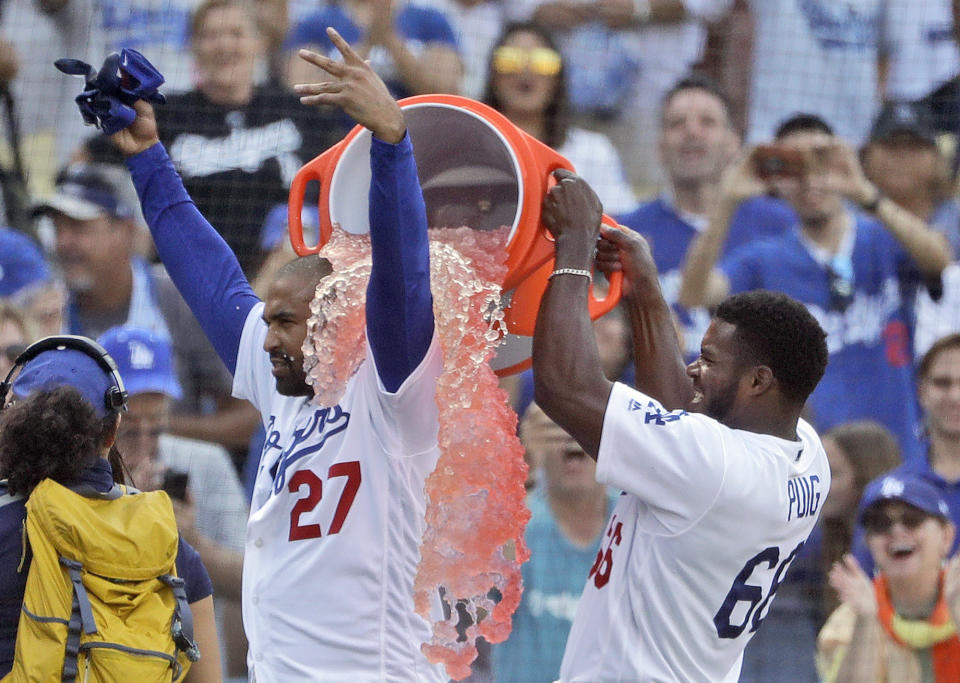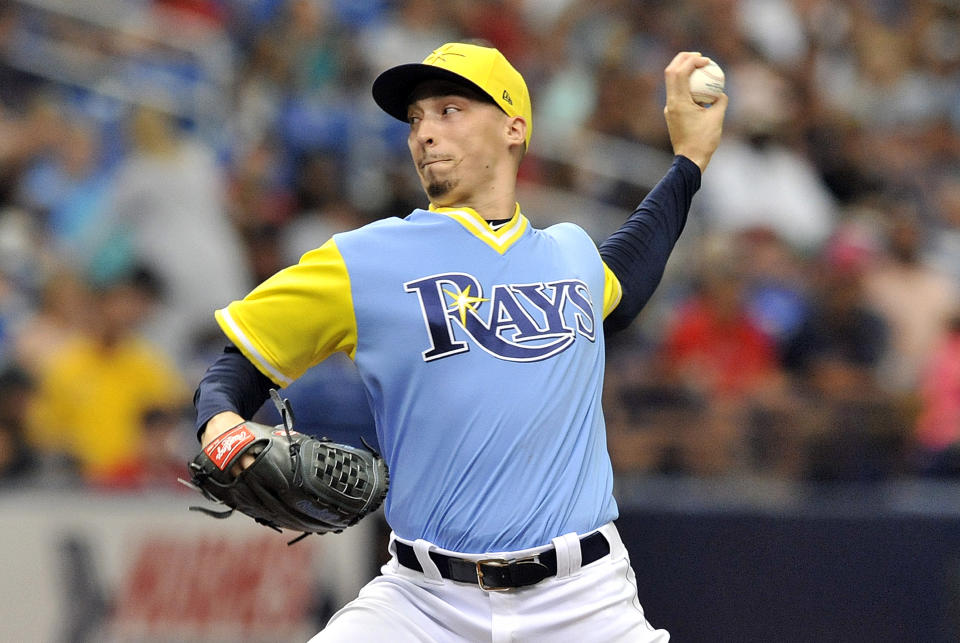10 Degrees: MLB's absurd rules that keep prospects like Vladimir Guerrero Jr. out of the majors
What’s most frustrating about Vladimir Guerrero Jr. and Eloy Jiménez not gracing stadiums, nightly broadcasts, highlight shows, sizzle reels, memes and every other square inch of baseball-related programming this September is the reason for their absence from the major leagues. It is the purest and most repugnant distillation of capitalism in baseball, and it feels silly to even type something this illogical: Guerrero and Jiménez have been so good, it pays to deny them the promotion they’ve earned.
Think about that. About doing great work – beyond-great work – and being penalized for it. It’s infuriating. It’s unfair. And it happens again and again and again in baseball, a sport that every year jerks around so many of its finest young talents for one reason only: control. Even though Guerrero is unquestionably one of the best players in the Toronto Blue Jays’ organization and Jiménez the same for the Chicago White Sox, the teams still needed to ask themselves a question: Is one month of them now worth one year of them in their primes?
Because that’s the calculus. And of course the answer was no. However liberating it may feel to flay the Blue Jays and White Sox for filching Guerrero and Jiménez’s well-earned spot on a major league roster, the manipulation of elite talents’ service time is clearly the right strategy for all teams, particularly rebuilding ones like the Blue Jays and White Sox. Admitting that is not siding with the teams; it’s a call for them to work with the MLB Players Association and figure out how not to punish teams for promoting good players.

The current rules state that a player needs 172 days for a year of service and six full years of service before he reaches free agency. If Guerrero or Jiménez debuted now, they would build up about 30 days’ worth of service time. By quashing any thought of a promotion now, it forces the teams to continue the empty excuses through spring training and the first two weeks of the season. By then, when a player can no longer accrue 172 days, he can be summoned for his debut, that extra free agent season secured.
“I hate doing it,” said one of the many general managers who has engaged in service-time manipulation. “But if I didn’t, I wouldn’t be doing my job.”
Just how much GMs hate it is up for debate. They didn’t exactly clamor to change service-time rules during the last collective-bargaining negotiations. Neither did the MLBPA, even after the March 2015 statement in which the union grumbled “Today is a bad day for baseball” when the Chicago Cubs rewarded prospect Kris Bryant for an incredible spring training with a trip to the minor leagues. Three weeks later, he was back – and that season, he earned 171 service days, one shy of a full season.
This is very much a scorpion-and-frog tale. Provide executives opportunities to extract value, and their nature will win out. A player deserved a promotion? Ha. The organization deserves to be successful for as long as possible, and it is a GM’s job to pull levers to ensure that happens. Fans want to see the player? Sure – and fans want even more to see a winner, which, one can argue convincingly, is likelier with baseball’s version of a Faustian bargain.
The executives are not the devil. The system is. And yet because it’s a system that has made many men rich and many owners richer, the establishment is loath to abandon it for something novel and progressive. The certainty of unintended consequences scares in particular ownership, whose can’t-see-the-forest-for-the-trees approach to service time may not be factoring in baseball’s waning attendance, its troublesome demographics, its myriad reasons to want players in the major leagues when they’re ready to succeed, not when their service clock suggests.
This is not to say Guerrero or Jiménez’s arrivals would reverse any of baseball’s deeper-rooted problems. More than anything, it would be a nod to those who wonder, rightfully, whether the prime motivation of baseball teams anymore is to place a winning product on the field. Because when the Blue Jays are ending …
1. Vladimir Guerrero Jr.’s season after he batted .381 as a 19-year-old against the best the minor leagues had to offer and the White Sox are sending Eloy Jiménez home after slashing .337/.384/.577 as a 21-year-old between Double-A and Triple-A, it says, quite clearly, that both teams care more about that extra year of service than they do winning now.
And whenever MLB denies that it has allowed anticompetitive behavior to proliferate, well, that’s a pretty good argument against the league’s spin – teams just blatantly saying six years down the road is more important than now. Because remember, that’s what we’re talking about here: If the Blue Jays and White Sox keep Guerrero and Jiménez down for the first few weeks of the 2019 season, they’ll reach free agency following the 2026 season, not 2025 as they otherwise would.
How to remedy this is among the most-debated topics inside the game. Even ideas that sound good in principle are ripe for criticism and get shredded rather quickly.

One GM this week suggested a system that mimics hockey’s, in which a player is a free agent at age 27 or after his seventh year in the league. The principles behind the idea make sense. In a system based on age and not service, teams know exactly how much control of a player they have when they sign him. With teams increasingly wary of giving long-term contracts to players in their 30s, a surplus of age-27 free agents would redistribute money to younger players.
At first, a scout liked the idea. Then he wondered how fair it would be for 16-year-old Latino players to be stuck with one organization for 11 years while older college players wouldn’t even be with a team for five seasons. Or whether teams would simply stop signing older college players because the juice wouldn’t be worth the squeeze. And whether kids then would see college baseball as an impediment, not a conduit, and start abandoning that level of the game.
A large-market executive immediately put the kibosh on the plan, arguing that it would kill smaller-market teams. If players were reaching free agency at age 27 (or 28 or even 29), he said, the richest teams would feel far better about signing younger players on the open market and monopolize the practice. The have-nots would have even less. The big-market/small-market chasm that exists already would widen. It may get Vlad Jr. and Eloy up sooner. It may destroy the game, too.
Even in the case of …
2. Byron Buxton’s service-time manipulation – which is perhaps even more egregious than Guerrero and Jiménez’s – the solutions aren’t entirely clear.
Typically with someone of Buxton’s ilk – three previous seasons with major league experience, including a 5-WAR year in 2017 – teams do not blatantly demote someone to finagle with service time. While Buxton struggled during his 94 major league plate appearances this season, he played hurt and has been good enough at AAA to warrant a return.
The Minnesota Twins said they do not plan on recalling Buxton, which would leave him with two years, 159 days of service – 13 shy of a third full season. The denial of those days would push Buxton’s free agency back from after the 2021 season to following 2022. Buxton is understandably livid. The Twins aren’t apologizing.

He has every reason to join Bryant and Philadelphia Phillies third baseman Maikel Franco among those who have filed grievances with regard to service-time manipulation. And though not as compelling as the others’, Ronald Acuña’s case – he’ll end the season 159 days after Atlanta summoned him in late April – warrants consideration as well.
Seeing Buxton sent home when the Twins trotted out an outfield Sunday of Robbie Grossman, Jake Cave and Johnny Field is embarrassing. The rationale trotted out by GM Thad Levine – that a wrist injury was lingering, his raw numbers in the minor leagues didn’t tell the full story and there wasn’t enough playing time – strained credulity. Like the Cubs’ explanation of keeping Bryant down. And the White Sox’s for Jiménez on Sunday. All of them comes from the same place, in which executives try to craft a plausible reason and wind up sounding disingenuous. It wasn’t quite as bad when …
3. Josh Donaldson was placed on the disabled list late Monday morning and promptly hit a grand slam Monday night, but then baseball rules and mores are pretty weird.
The entire Donaldson deal, which sent the former MVP from Toronto to Cleveland, was odd, from Donaldson’s anger over how his calf injury lingered to the rush to get him back into minor league rehab games so he could be declared healthy (and traded) to Toronto shipping him out for a player to be named later to the DL’ing.
On Saturday, Donaldson donned an Indians uniform in their dugout. A day later, he took batting practice with his new teammates. Rather than activate him on the major league roster, the Indians wanted Donaldson to face live pitching. So they put Donaldson on the big league DL in the morning and shipped him out to AAA Columbus, where he hammered a ball to dead center.
The plan is for Donaldson to return Sept. 11, by which time the Indians may have clinched the AL Central, where their magic number is 12. Which happens to be the same number of games …
4. Daniel Murphy has played for – and led off for – the Chicago Cubs. Until Murphy arrived via trade from the Washington Nationals, the Cubs had tried nine leadoff hitters – and from every position, too, as a matter of face.
Manager Joe Maddon didn’t hesitate to put Murphy in the leadoff spot, even though his last game there came June 12, 2014. Combine that with seven games in 2013 and four in 2009 and, yes, Murphy now has led off as many times for the Cubs (12) as he did in his other 1,244 regular-season games.
Chicago is 10-2 with Murphy in the leadoff role, and the Cubs’ depth has allowed them to work around his defensive deficiencies by yanking him in the seventh, eighth or ninth inning in 10 of 12 games. As usual, the bat plays, and Murphy’s comeback from offseason knee surgery keeps improving. It’s not quite at …
5. Matt Kemp level yet, but then again, what is? As infected as a celebration of Kemp’s excellence may be tainted by recency bias – fine, is tainted by recency bias – ruining Archie Bradley’s night is a very difficult thing to do, and to do it two nights in a row speaks to the weekend Kemp had.
First came Saturday night against a Diamondbacks team that looks ready to blow its playoff spot. Kemp’s three-run homer in the eighth to center off Bradley pushed the Dodgers ahead in a 3-2 win. The next night, he walked off Bradley with a two-run double to center that helped the Diamondbacks slip from atop the division to third place.

What’s been so revelatory about the 33-year-old Kemp is how on a patently unclutch team, he’s been the standard bearer of big-time moments regardless of the measure. In context-neutral situations, he’s awesome, with an OPS nearly 250 points higher with runners on base than the bases empty. His slash line with runners in scoring position is even better: .356/.400/.604. In so-called high-leverage situations – clearly more important in the scheme of a game – Kemp is slashing .306/.364/.500. The Dodgers as a whole: .221/.304/.341.
A loss Monday pushed the Dodgers a half-game behind the Colorado Rockies, who are in first place in September despite being outscored by 14 runs this season. As good a predictor as run differential can be for a club’s record, it is like exit velocity for batters. Just because …
6. Aaron Judge hits the ball harder than everyone doesn’t mean he’s better or his balls land at a higher rate. Still, it’s much easier to prefer the player who hits the ball hard, like it is to with the team that outscores others significantly. And so the return of Judge to taking swings after missing six weeks with a wrist injury is reason for cautious optimism – and the Yankees’ +147 run differential is reason for them not to be quite as concerned about the Oakland Athletics.
Here Oakland is anyway, creeping to within 3½ games of the Yankees for home-field advantage in the wild-card game with two games left in their series at Oakland Coliseum. The A’s lead Seattle by 5½ games for the second wild-card spot, and the Yankees could bury the Mariners when they head there following the Oakland series.
The A’s playing nearly .600 baseball – a 96-win pace – is incredible enough. That they’ve been able to outlast the Mariners – who since peaking at 55-31 on July 3 have gone 21-30, better than only Baltimore, Detroit and Kansas City in the AL – is a testament to how well the A’s played in that stretch: 35-17, second only to Boston’s 36-15.
The Mariners’ collapse is almost complete. They’re only 2½ games ahead of …
7. Blake Snell and the Tampa Bay Rays. The 25-year-old left-hander, who arrived in the major leagues two years ago and was perfectly average last season, is the heir to Chris Archer, who was the heir to David Price, who was the heir to James Shields, who was the original Rays starter worth a damn.
Snell is worthy of the title. The Rays don’t bother using an opener when he’s pitching. His fastball sits at 96 mph, two ticks up from when he arrived. His slider zooms in at 88, nearly 5 mph higher than as a rookie. His stuff gives hitters fits like only one other left-hander: Chris Sale.

A Sale comparison is the highest compliment possible for a left-hander, and Snell is earning it because he’s threatening to beat Sale out for the AL Cy Young. He now has thrown more innings than Sale, and Snell’s ERA (2.02) is negligibly different from Sale’s (1.97). Yes, Sale’s peripheral numbers are clearly better, and yet as he has bounced on and off the disabled list – he’s due back in the next week or so, as an opener, interestingly enough – Snell has gone 5-0 with a 1.10 ERA since the All-Star Game.
Snell, too, dealt with a bout of shoulder fatigue, though he hasn’t missed a beat. The same cannot be said for …
8. Joe West after his latest foofaraw, in which he confiscated an analytics-laden notecard from Philadelphia reliever Austin Davis because he deemed it a “foreign substance.” MLB alerted managers the next morning that paper was not, in fact, a foreign substance and could be used on the field.
West playing rulebook pedant is nothing new, of course, but the swift response and smackdown by the league was a reminder that along with the unwritten rules, the blowhard is becoming a dying breed in baseball. Know-it-alls don’t play nearly as well in 2018, whether it’s in the manager’s office, behind the plate or in the announcer’s booth.
It was funny, in a way, to hear Hawk Harrelson, the longtime Chicago White Sox announcer nearing the end of his career, fill out another square on his blowhard bingo card over the weekend. He said he no longer would watch LeBron James. “I wish these guys would keep their nose out of politics and just play,” said the guy who clearly put his nose into politics during the baseball game he just announced.
What Hawk never seemed to understand is that he and Joe West – someone whom he has criticized in breathless, heaving rants – aren’t that different at all. They both love attention. They love a game that has changed as they haven’t. And their stubbornness is their defining characteristic. They are unapologetic blowhards. And they are going away like …
9. Shohei Ohtani’s velocity in the third inning Sunday. In his first start back from missing two months with a partially torn ulnar collateral ligament, Ohtani made it through the first two innings looking like his typical self before losing upward of 7 mph off his fastball sitting in the 98-mph vicinity.
Los Angeles Angels manager Mike Scioscia blamed a tight back, a sore finger from the comebacker he tried to barehand – pretty much everything but problems in the elbow, which clearly correlates more often with a loss of velocity. And that may well be the case. Trying to figure out the severity of an elbow injury without any information from the team is almost impossible, and so there’s no sense in guessing.
It’s impossible, too, to say whether bringing Ohtani back now is worth the risk. How has Ohtani’s UCL healed, if at all? How does his hitting affect it? Would he have been better simply hitting the rest of the year and giving the ligament seven months to recover? Only the Angels know, and even they don’t really know, not when Ohtani is a sample of one.
His next start is scheduled for Sunday against the White Sox, and he’s got three more lined up after that. No matter how many, he’ll still be out there while …
10. Vladimir Guerrero Jr. and Eloy Jiménez wait for their turns as big leaguers. And they’ll wait. Because the Blue Jays and White Sox didn’t endure the grief they’ve gotten to fold in spring training and roster either of them as they break camp. At some point in March – maybe the middle of the month, as with Acuña – they will be sent to Triple-A with a mandate to work on something or another. They will. And by May 1, they’ll be in the major leagues for good.
Then it’s onto the next guy, the problem always the same. It’s not normal for a sport to say: Yes, we have a player people want to see … and we’re going to do everything we can to make sure people can’t see him. The manipulation of elite talent’s service time is simply part of teams’ business plans. And as one executive put so well, this doesn’t evolve because it’s part of a deeper system, one that institutionalizes the notion of players as assets at all levels, from the lowest rookie league to the big leagues.
“Some teams are still serving sandwiches for the spread,” the executive said. “The players are like children. They don’t get rights. They don’t get [expletive]. They are told when they are grown up based on a financial marker in most cases. It’s not a good system, especially for the kids. I get it. But as long as teams have this much control over a player, it won’t change.”
If there’s a mutually beneficial solution, the players and league owe it not just to one other but to fans to find it. Because right now, baseball should be celebrating Vlad Jr. and Eloy and Acuña and Juan Soto – the greatest wave of young Latin American outfielders to arrive at the same time perhaps ever. In Toronto and Chicago, there would be madness – that the day they’ve waited for is finally here.
Best of all, it would be right for the game. Baseball deserves Vlad Jr. playing in September. It deserves Eloy hitting a tape-measure home run or two in this final month, his first as a big leaguer. It deserves all that, because the best players playing in the major leagues at all times shouldn’t be some of a foreign concept. That should be the rule.
More from Yahoo Sports:
• Broncos cut QB they thought would lead franchise
• Gruden makes his case for Raiders’ shocking trade
• Nick Saban apologizes for postgame conduct
• MLB postseason picture takes shape

 Yahoo Sports
Yahoo Sports 
